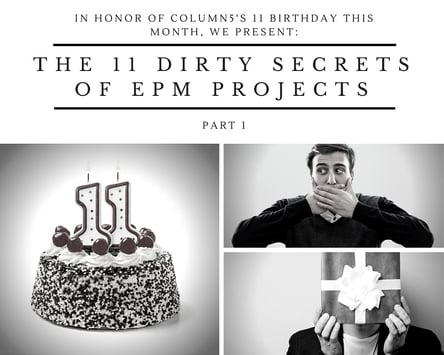
Though the actual market size may vary, a reasonable estimation states that throughout the world more than $4 billion is spent annually on EPM consulting alone. Yet, EPM projects often fail to return positive value to those investing in them. Why is this outcome so prevalent with this technology solution in particular? I thought for Column5's 11th birthday, I'd give our more than 1000 blog readers a gift! I’ve wrapped it up and called in the 11 'dirty secrets' of EPM projects.
I know this is heresy to disclose some of these EPM professional services insider secrets, but I care more about you being successful than I worry about the flak I will inevitably get by letting you in on these secrets. Let’s begin:
Dirty Secret #1: Consultants aren't often trained
 As an EPM customer, you know that EPM training is not as ubiquitous as for other technologies. Every junior college, night school, and online training site has classes on Excel, but where are the classes for EPM? Not only are they outright hard to find, but once found, EPM training often costs weeks of time and significant money to get even basic training. Add major software changes every 18 months to 2 years, and you have a knowledge gap such that it is rare to find any individual fluent on all product functionality and related processes. Getting a consultant fully trained is nearly impossible, and keeping them up to date is even more difficult. This requires a serious intent and investment - can anyone reasonably afford to make the necessary investments?
As an EPM customer, you know that EPM training is not as ubiquitous as for other technologies. Every junior college, night school, and online training site has classes on Excel, but where are the classes for EPM? Not only are they outright hard to find, but once found, EPM training often costs weeks of time and significant money to get even basic training. Add major software changes every 18 months to 2 years, and you have a knowledge gap such that it is rare to find any individual fluent on all product functionality and related processes. Getting a consultant fully trained is nearly impossible, and keeping them up to date is even more difficult. This requires a serious intent and investment - can anyone reasonably afford to make the necessary investments?
What I have found is the answer is typically: “no”. With the high cost of training, consulting firms often send one or two resources to attend an EPM session here and there, and hope they will develop content to ‘train the trainer’. With consultants out in the field, the argument is often, “I don’t have time to take a week to train. I’m too busy”. Who winds up paying for on the job training of minimal scope when consultants are forced to learn a new version or system? Customers. This could be the biggest source of problems for implementations and customers don’t know to ask for these details when deciding which provider to go with; often they assume that, ‘of course all consultants involved in our project will be trained’. This is rarely the case.
At Column5 Consulting, I have made access to cost effective training a major strategic priority. We have created our EPM Academy – which exceeds SAP’s content in volume and quality, and I can say with confidence that no other EPM partner comes close to this offering. This asset tied to our flexible pricing and timing options keeps our clients from being forced into a situation with training “haves and have nots”. For the best outcomes on EPM projects, I believe everyone touching the software should be formally trained – starting with consultants- and training should cover every single user. I implore customers to ask hard questions about the training process of any potential consulting partner and, also, what the plan would be for enabling the client’s project to succeed all the way to the end user. My advice is to not compromise here!
Dirty Secret #2: Blueprint Standards are not defined
 When you take your car into the repair shop, you expect each ‘certified mechanic to approach challenges in more or less the same way. There is even a universal book that lists out industry standard times to complete certain tasks. A mechanic could say to a customer, “the book says that that repair should take 3 hours” even though he or she hasn’t personally performed this repair before. The mechanic book authors work with the vehicle manufacturer to list all necessary steps to get the job done properly. This readily accessible knowledge has created a high degree of consistency, and comprehensive quality, regardless of the repair shop you visit. Maybe, until reading this secret, you figured that EPM design standards are just as well defined and widely distributed. Unfortunately, this is far from reality.
When you take your car into the repair shop, you expect each ‘certified mechanic to approach challenges in more or less the same way. There is even a universal book that lists out industry standard times to complete certain tasks. A mechanic could say to a customer, “the book says that that repair should take 3 hours” even though he or she hasn’t personally performed this repair before. The mechanic book authors work with the vehicle manufacturer to list all necessary steps to get the job done properly. This readily accessible knowledge has created a high degree of consistency, and comprehensive quality, regardless of the repair shop you visit. Maybe, until reading this secret, you figured that EPM design standards are just as well defined and widely distributed. Unfortunately, this is far from reality.
In the EPM industry, unlike in the mechanic trade, rarely does the software vendor prescribe a book of “how to properly configure solutions to meet specific needs”. The whole industry, it seems, perpetuates the myth that starting with a blank slate during the design allows maximum flexibility since every customer has a slightly different approach to EPM processes. This mantra couldn’t be further from the truth. A lack of standards across service providers means every consulting firm is going to have widely varying approaches, standards, and consequently…widely varying project outcomes.
As a customer, how can you begin to tell who has the standards and processes to produce a consistent, successful outcome? If I were a customer, I’d ask questions to uncover if there’s a system of checks and balances within a potential consulting firm to produce consistent results, even on a team or individual basis. I would know that this type of system requires consistency and deliberate investments. Some questions I’d ask to discover their process, (if there is one):
- Do they have a PMO? (Or do they fulfill “PM” tasks with consultants responsible for both developer and project management tasks?)
- If they have a PMO, does this group have a rigorous process established?
- Are there proactive QA steps to review the quality of the work?
- Do they have prepackaged solutions that can be deployed with greater consistency and quality?
Read Also: The Top 5 Things to Consider When Selecting a Consulting Partner
Customers who don’t typically know to ask these questions pay a premium. Haphazard results, success dependent upon which consultant you get, and unreliable outcomes are the consequences of being shortsighted here.
I have made sure that Column5 has all of the above processes in place for the benefit of our customers. From time to time, Column5 loses bids based solely on price during which customers lecture us, “you are x% higher than the other guys, for the ‘same’ solution and I couldn’t justify it on my P&L”. The premise of that conversation centers around their belief that the each potential provider is equal in value of service and outcomes, so only the correlated pricing is different. They may believe that obscene profits and gouging must be the only price differentiator between offers. The reality is the low pricing delta directly correlates to corners cut that will be cut to risk on the customer’s side. Most often this increased risk is not noticed by the customer during teh negotiations.
Too often, within an 18-36 month time frame after a customer chooses a lower cost provider, we see that customer returning to our door, this time with a horror story of challenges during their proposed project. To this customer’s surprise upon return, our original proposed services and cost structure predicted those challenges and would have prevented the wasted time and resources on that outcome. What I find (and they do too) is that when purchasing from us they didn’t only buy an EPM solution, they bought an education on how to structure an EPM project for reduced risk.
If the same price obsessed employees are around for another EPM project, they will be much better equipped with experience to make more informed choices. The customer doesn’t often know to ask the above questions until it’s too late to reveal the true underbelly of their potential EPM service provider. Often in their lineup of solution providers, one company has made the prerequisite investments and commitments to a structured process to achieve positive results consistently. While the other option touts affordability while “winging it” and hoping for the best in the guise of being actually responsive to the customer’s “needs”.
Dirty Secret #3: Contractors are used unbeknownst to customer
One question we don’t get near enough during customer interactions is “how many of your workers are contractors?” There are many so-called consulting companies that only have a handful of actual employees on staff. The rest of their alleged team is a broad list of transient resources that are only called upon when and if specific work is needed. Column5 is in stark contrast to the rest of the pack.
If you have been reading this blog for any time, you know Column5 is all about EPM, all the time. ERP consulting firms, BI firms, Accounting firms, and other providers often have to contract to get what they perceive to be qualified resources to fulfill their EPM needs. I suppose it’s a bit of a romantic myth to think of the lone EPM gunslinger riding into town who singlehandedly gets all the villains put in jail as he or she rescues the damsel in distress. Who needs to hire a proverbial sheriff’s department if the lone gunslinger can solve all the problems at a much lower price? But one misguided gunslinger, with no previous experience in a new town, may just as easily ride away with the villains into the sunset, leaving the damsel and townsfolk in jail. In reality, this romantic myth assumes incorrectly that contracting individuals, a collaborative team of specialists following ingrained processes, yields equal or better results.
If the lone gunslinger wasn’t enough, let’s try a sports analogy to more fully color this situation. Imagine fielding a team made up of players under contract for one game. They meet just before the match, bringing varied and random backgrounds, training, and experience. They walk into the stadium wearing the same uniforms, but they often have no idea what to expect from each other. They are (as a rule) not particularly loyal to the company that hired them, and any efforts to hold them accountable for missteps may drive them off. This is about as risky a situation as you’d could get, yet is very common.
Column5 has W2 employees that have worked together for a long time to deliver EPM solutions. They are uniformly trained, managed, and loyal to both our company and our clients’ needs. We are a seasoned team of devoted EPM athletes and an experienced EPM sheriff’s department ready to face any new challenge.
Dirty Secret #4: Fixed bids
Like most things in life, deals that seem too good to be true often are. Tough talking procurement managers, IT leaders, and business folks sometimes insist on fixed bids. Sometimes competitors throw them out as a last ditch incentive to convince the prospect. They bait with “We are so confident in our numbers, we will fix the cost of the project!” This very tempting engagement structure can be quite compelling to those early on in their EPM project success education. In reality, the dirty secret is these arrangements are not often in the best interest of the customer.
Counterintuitively to a building a lasting mutually rewarding relationship, fixed bid tactics are used to rapidly conclude otherwise healthy discussions that drill down on the specific deliverable requirements, quality standards, and other details of the project that would certainly impact the quality of the outcome. In addition to allowing these discussions to continue, there are other long-term success factors to consider when deciding on a fixed bid offer. Non-fixed contract approaches allow flexibility to adapt deliverables as the client team learns more about what EPM can do through the design, pilot, and even realization stages. Locking into the requirements ‘sight unseen’ can be a very limiting position to take for both sides, especially for the customer.
The very nature of the fixed bid contract encourages the implementation team, who is motivated to spend the least time possible on a project, to deliver the least functionality that can achieve customer sign off. By doing so, there’s no room for the implementation team and the customer to explore hidden value maximizing opportunities that could pay even bigger dividends. Customers think they're getting a 'deal' and shifting ROI risk to the provider. In reality, the provider is now incented to use the lowest cost approach to convince the customer the requirement has been met. Fixed bid projects are agreed on under the thinking that customer risk is contained, but it is not. Not only do customers gain more risk, but they also may miss valuable opportunities that are passed over in the name of time efficiency.
At Column5, we will do fixed bids if customers insist, but we always try to have a discussion about the best interests of project success. Agreeing to proceed on a fixed bid basis is a reluctant position for the reasons stated, and we advise the customer to go into the project step by step. If fixing is important, start by fixing the blueprint. This ensures both parties can invest the proper amount of due diligence on the requirements to ensure alignment on what success looks like and the necessary steps get there. Any time short cuts that are sold as more valuable or risk reducing for the customer …look out.
Dirty Secret #5: Implementations have significant gaps in functionality
I continue to be amazed to hear about projects that didn't have time to do basics like data integration or the like until phase 2, which they convince the customer is a prudent phasing. That’s like a car salesman saying he’ll attach your wheels when you get to 10,000 miles. Not only will your experience be totally different when you ‘do it right’, but the value received for that first stage will be hard to see.

A novice customer to EPM might fall for some of these situations initially. But once the solution is properly configured, they’ll realize they should NEVER have tolerated the deliverables they were told were reasonable on the first go around. I could write ten blogs about all the features and functionality left out on bad projects in the name of “just doing what it takes to go live.” I think that would be great fun for readers, but certainbly not for those on that project. Since these situations happen so often, instead of my wickedly fun blog series, we have developed a comprehensive review process that exposes phasing mistakes made and the opportunities for improvement that exist. If you are wondering whether your implementation suffers from these “gotchas”, or you know you have these issues and you’re wondering what to do next…visit our page on EPM Assessment.
Our view: maximum automation is table stakes when buying and implementing any EPM solution, but it is not the only destination. Completing a project and leaving intact manual processes like keying (or cutting and pasting) data is extremely negligent. Expecting users to tolerate major lapses in the system that require reboots & error messages, manual reconciliation, awkward user interfaces, and poor performance are telltale signs that serious flaws exist in the delivered solution. My recommendation is to get qualified assistance to evaluate the situation as soon as possible before it gets worse and, from my experience, it most certainly will.
Dirty Secrets of EPM Projects: Part 2
Join with us in wishing Column5 a happy 11th birthday! if you have any questions about how EPM could function for you, please contact us below!
More content by Dave Den Boer you might like:
Blog Post: EPM and the Wisdom of Sun Tzu
Blog Post: Column5 through the Years
Blog Post: Choosing the Ideal EPM Implementation Partner Series
Webcast: Customer Roundtable - BPC Performance Issues
 Author Bio:
Author Bio:
David Den Boer founded Column5 Consulting in 2005. Under David´s leadership, Column5 has evolved beyond its reputation for technically superior solutions to be an influential global provider of high—value EPM solutions. His prior experience includes consulting experience as Director of Services at OutlookSoft from 2000 to 2005.
David Den Boer, Founder & CEO












